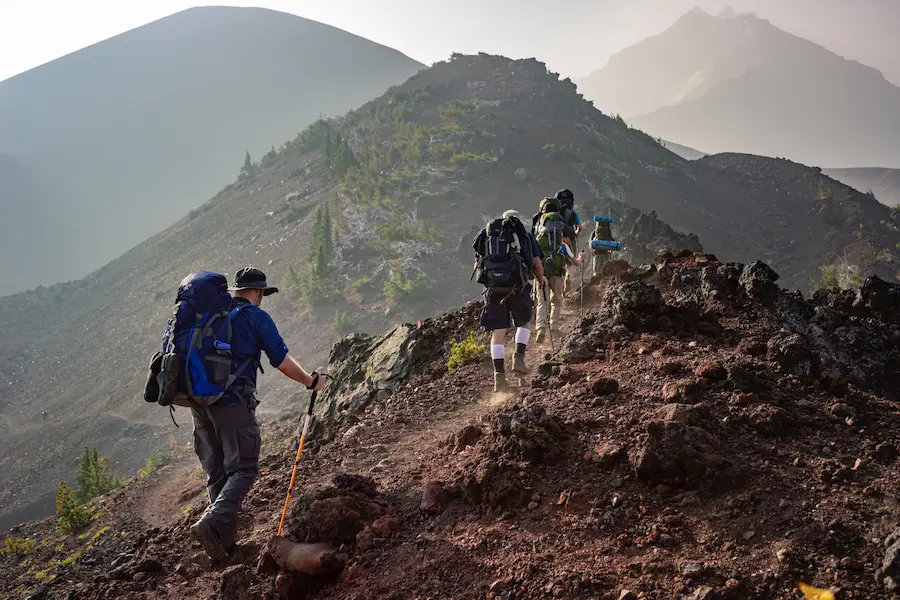Some people use hiking as a form of exercise, while others use it as a way to socialize, reflect, observe, experience nature or enhance their mental health. no matter what your intention is, those prolonged, exhausting walks; especially when combined with a weighted vest, can help you strengthen your body and build muscle.
Weight vests are pieces of military clothes that are stuffed with heavy objects, usually sandbags, to make moving around more difficult. While hiking, these vests help you develop muscle and improve your fitness by evenly distributing weight around your torso (trunk of the body).
Is the Weighted Vest Beneficial when Hiking?
- There is a strong “yes” to this question! The ability to gain more muscle mass is one of the main advantages of hiking with a weight vest. When climbing up a hill, the vest’s additional weight puts more strain on your muscles, forcing them to work harder and, over time, developing more effectively.
- Using a weighted vest while hiking not only helps you gain muscle but also strengthens your heart. Your heart has to pump harder to send blood throughout the body as a result of the extra weight, which gradually improves your overall stamina and fitness.
- According to a recent study by the American Council on Exercise (ACE), wearing a weight vest while hiking can help you burn 12% more calories than normal hiking. Therefore, hiking with weight vest is a good exercise to lose weight too.
- Leg workouts like hiking are excellent, but adding a weight vest can amplify the workout and support muscle growth in legs. As you hike, the extra weight will make your muscles work harder, giving your legs a better leg workout. Consider wearing a weight vest while hiking if you want to build up your leg muscles. You’ll be able to hike farther and faster with less exhaustion in addition to seeing better muscle tone.
- Finally, those looking to enhance their coordination, stability and balance should consider hiking while wearing a weight vest. As a result of the additional weight, maintaining your balance becomes more challenging, requiring you to employ more muscles and coordinate your movements much better.
6 Tips to Hike with a Weight Vest
First, mindset is vital. Instead of something you do when you’re exhausted and in need of a break, reconsider thinking of hiking as a strategic choice. The secret is deliberate practice. Not just walking, but making it a habit by forcing yourself to walk faster almost every time. It’s about training your body to endure the hardship.
1. Choosing a weight vest with appropriate weight
The decision you make here is based on your body weight, however the goal isn’t to make it incredibly challenging. Most inexpensive weight vests contain about twenty pounds of sandbags, which is sufficient to provide the majority of hikers with an ideal training stimulus. Start off with a lighter weight, just enough to make you aware of the added effort needed, and gradually increase it.
2. Start slow
It’s important to start out slowly with any new exercise regimen. This is especially valid when wearing a weight vest while hiking. Start by adding a few pounds to your vest, then as you get more at ease, gradually add more weight. This will reduce the likelihood of injury and give your body some time to get used to the extra weight.
3. Go on short hikes at first
Irrespective of your level of hiking experience, make sure to keep your hikes short when you start wearing a weight vest. As your body gets used to the extra weight, start with 15 to 20 minutes and work your way up. Consider all the additional heat that the thick layers of clothing add to your body if you are hiking in a warmer environment.
Give your body time to ventilate and cool off more often, because heat stroke is dangerous and occasionally fatal.
4. Drink a lot of water
Drinking water while hiking is crucial, especially if you’re wearing a weight vest. You sweat more when you are heavier and thicker, so it’s critical to drink plenty of water at all times. Even if you don’t feel thirsty, keep a water bottle on you at all times and sip from it frequently. It will also reduce the chances of leg cramps because dehydration causes cramping. So do not ignore drinking water on regular intervals especially when hiking in hot temperatures.
5. Maintain your posture
The best way to lower your risk of injury when hiking with weights is to maintain proper posture. While good posture is critical, it is especially crucial when lifting weights. Your joints are put under stress and strain by poor posture.
When hiking, walk with a weight vest while maintaining a straight posture, relaxed shoulders, and light footing.
6. Maintain your pace
It’s not a good idea to walk fast when adding weights to your hiking routine because you are at risk of suffering a joint injury. Make sure to maintain your speed until you feel confident enough to increase it along with the weights.
Conclusion
Therefore, wearing a weighted vest while hiking is a great way to increase your strength, balance, and fitness. Weighted hiking is a good cardio and strength-training workout. Be aware of your limitations when wearing weight vests. Start off gradually and with lighter weights. As your resistance increases, you can gradually hasten your pace and add weights. Even though it might not be the best option for everyone, those who can hike while wearing a weight vest will certainly benefit.
FAQ
1. What is a weighted vest?
A weighted vest resembles a military vest and usually has pockets for storing or removing weights. The vest’s weight varies, but it typically sits between 12 and 150 pounds (5.4–68 kg).
2. What are the benefits of hiking with weight vests?
They increase the body’s resistance in a more consistent and controlled manner. They also aid in increasing strength overall, bone density, cardiovascular efficiency, and endurance.
Read more:https://worldvisitguider.com/hiking-jokes/


